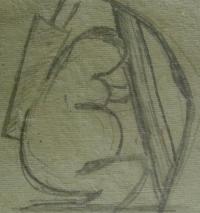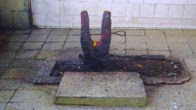The Kamakhya temple is situated atop the Nilanchal hills, eight hundred meters above sea level, overlooking the mighty Brahmaputra. It is about eight kilometers west from the heart of the city of Guwahati in Assam.
Kamakhya is an important Tantric mother goddess closely identified with Kali and Maha Tripura Sundari, according to the Tantric texts (Kalikapurana Stotra, Yoginitantram) that are the basis for her worship. Her name means "renowned goddess of desire.’ As Kamakhya is associated with fertility, many childless couples also throng the temple every day. In Kalika Purana, Kamakhya is referred as the goddess who fulfills all desires, the bride of Lord Shiva and the benefactor of salvation. Kamakhya is one of the 51 Shakthi Peetas of the sub-continent where Durga is worshipped in many forms.
Mythology: Sati (Dakshayini) the daughter of King Daksha who had married Lord Shiva much against the wishes of her father went, uninvited, to the Yagna that Daksha was performing. She was ridiculed by her father for attending without an invitation. Daksha hurled abuses at her husband and humiliated them. Deeply hurt and angry, Sati threw herself in the blazing fire of the Yagna and died. Shiva was infuriated. Killing Daksha, he hoisted the dead body of Sati over his shoulder and began the Thandava- a dance of Annihilation.
This shook the universe and frightened the Gods. Lord Vishnu, Brahma and Shani ventured to put an end to the blind fury of Shiva. With the help of his Sudarshana chakra, Vishnu reduced the body of Sati to pieces and Shiva, without his wife’s body, returned to meditation.
However, Sati’s body parts, 51 in all, fell all over the earth and each of these places is revered as holy. The organ of generation (Yoni or the genital organs) of Sati fell over the Nilanchal Hills and today is known as Kamakhya Temple. (Assam was known previously as Kamrup Kamakhya desa)
Kama, the God of Love who was reduced to ashes when his arrow targeted Shiva, regained his original form (Kamarupa) after he fulfilled his promise and built a temple for Sati.
Mythology also has it that Narakasura tried to build the path to the temple overnight with a desire to wed Kali but was killed when he failed to do so.
According to history, the original temple was destroyed by invaders and had to be restructured. King Naranarayan of Cooch-Behar in the late 17th century is credited with building the present temple. Representing the old Ahom sculpture, the vertex of the temple is oval shaped; like beehive-having 7 spires, 3 golden pitchers on blossoming lotus and upon that a golden trident. The temple exterior flaunts beautiful frescos of adorned gods & goddesses of Hindu Puranas.
********************
On arrival atop the hillock, priest Ramani Kant Sharma escorted us to the temple premises. He took us to the Sauvagya Kunda where we washed our feet and hands, sharing space with a duck and a curious monkey. We placed offerings before a row of strangely sculpted Ganeshas, anointed with bright red sindhoor before ascending a cool flight of stairs to the temple precincts.
 |
| The Ganeshas |
The premise abounds with goats that wantonly amble, amidst generous droppings and pigeons that make homes in the eaves of the sculpted exterior and the air is a mix of strange scents, all familiar but individually unidentifiable! Sadhus who eye visitors with a hypnotic gaze pit the compound. A cache of bronze bells of various sizes (offered by devotees for special favors) hung alongside a wall
A particularly interesting sculpture on the walls captured me but I had no one to explain its significance. For my obstetrician eyes, it appeared as a woman straining during labor!
 |
| Prayer bells |
 |
| Is she bearing down? |
Inside the dimly lit temple, a tightly coiled serpentine queue of devotees mills silently towards the sanctum sanctorum. It is quite claustrophobic. The doors to the outside are silver coated and the interior has strange sculptures. Photography inside the temple is prohibited. So I had to quickly sketch an intriguing sculpture. It is a pregnant warrior, kneeling, with her head bent, a bow in her left hand and a quiver with few arrows.
Just before we enter the sanctum sanctorum, is an adorned platform for the idol of Goddess Kamakhya made of an alloy of eight metals. Kamakhya is pictured as a young goddess, 16 years old, with twelve arms and six heads (five looking front and one atop of them) of varying colors, representing a powerful goddess who is omnipotent, omniscient and omnipresent. She is ornately dressed, typically wearing a red sari, opulent jewelry and red flowers such as hibiscus. She holds in each of ten hands a lotus, trident, sword, bell, discus, bow, arrows, club or scepter, goad, and shield. Her remaining two hands hold a bowl, which is made of either gold or a skull. She is seated upon a lotus, which emerges from the navel of the corpse of Shiva, who in turn lies atop a lion. I cannot comprehend the mystical meaning in this (nor have I got it on the net, much as I scouted)
 |
| The pregnant archer |
 |
| Kamakhya |
There are ten steep steps down into the Sanctum Sanctorum, which is lit by oil lamps only. It is beneath the largest temple dome as the walls here are circular, almost appearing to be closing in on us. It is very cool here. Going down the steps, I get a strange feeling of entering a gigantic, hushed womb!
At the actual site, I knelt, bending towards the ‘Devi Kunda’, which is the Mother’s Yoni (Vulva, regarded as the symbol of divine procreative energy). The Yoni exists as a large cleft in the circular rock, covered by water springing upward, constantly, from an underground spring. The soft gurgle sounds divine! I can see the spring clearly but the cleft is covered by a red cloth, flowers, and red sindur powder. I am directed to scoop a handful of water (which is supposed to be reddish due to high iron content. But the color is not visible in the darkness). “Piyo,” the priest says and I oblige a mouthful. The water tastes sweet and strangely, I find myself wishing it were Ambrosia! I run my wet hand on my hair.
There is a similar neighboring wish-well attributed to Goddesses Lakshmi and Saraswathi. The ritual of par taking the sacred water is repeated.
We come out of the temple and wade through a sweet cloud of dhoop sticks and Sharma suddenly assaults our olfaction. He takes us to the sacrificial place. The altar had been just cleansed with water for the smell of blood hung fresh in the air. “Three or four buffalos a month and almost the same number of goats daily,” Sharma says. Then the special Panchabali ritual involves the sacrifice of a buffalo, a goat, a sheep, a pigeon and a duck and is a common practice in the Kamakhya temple. All the wanton goats in the premises, the duck at the pond and the pigeons.... would all pass this station some day! I suddenly want to leave the place.
 |
| The goats go down here.... |
 |
| and the buffaloes here..... |
We walk down the steps along the alley of tiny shops which are by now open and displaying the trivia which are so characteristic of every such place of worship- marigold garlands, bright red gold laced chunnis, rudrakshas, photos of Kamakhya, idols of Durga, prasads, sweets and brass ware. Devotional songs set to contemporary Bollywood music blare over woeful sound systems.
As we climb down the steps, brushing people climbing up to the temple, my right arm becomes moist. As I rub the generous mucus with my left palm, I realize that it is the saliva of a lamb that a devotee was carrying in his arms! I look back and lock eyes with it. The lamb is cute and black as it juts its wet spout beyond his cradling arms. Ten steps downward, I trip as it dawns that the lamb was being carried as a mid-afternoon offering to the goddess!
No comments:
Post a Comment